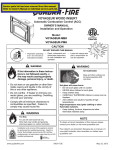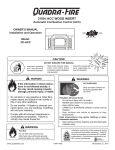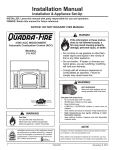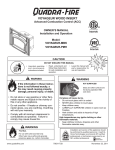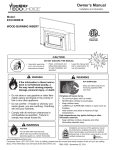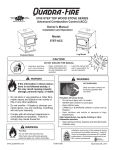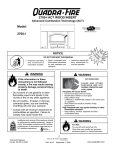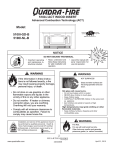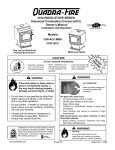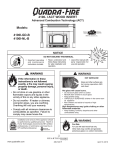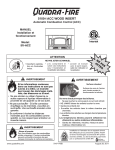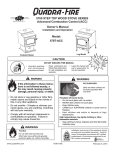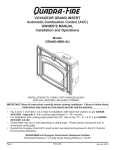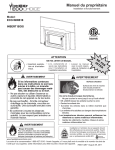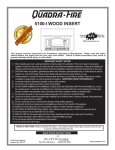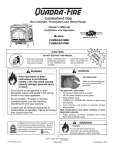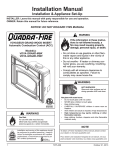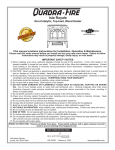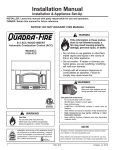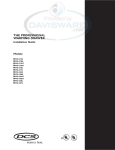Download Quadra-Fire 7046-137C User's Manual
Transcript
R Tested and Listed by 2700-I ACC WOOD INSERT Portland Oregon USA O-T L US C OMNI-Test Laboratories, Inc. Advanced Combustion Control (ACC) OWNER’S MANUAL Installation and Operation Model: 27I-ACC CAUTION DO NOT DISCARD THIS MANUAL • Important operating and maintenance instructions included. • Read, understand and follow these instructions for safe installation and operation. WARNING WARNING HOT SURFACES! If the information in these instructions is not followed exactly, a fire may result causing property damage, personal injury, or death. • Do not store or use gasoline or other flammable vapors and liquids in the vicinity of this or any other appliance. • Do not overfire - If heater or chimney connector glows, you are overfiring. Overfiring will void your warranty. • Comply with all minimum clearances to combustibles as specified. Failure to comply may cause house fire. • Leave this manual with party responsible for use and operation. D DI O N SC O AR T D Glass and other surfaces are hot during operation AND cool down. Hot glass will cause burns. • Do not touch glass until it is cooled • NEVER allow children to touch glass • Keep children away • CAREFULLY SUPERVISE children in same room as fireplace. • Alert children and adults to hazards of high temperatures. High temperatures may ignite clothing or other flammable materials. • Keep clothing, furniture, draperies and other flammable materials away. WARNING Installation and service of this appliance should be performed by qualified personnel. Hearth & Home Technologies recommends NFI certified professionals, or technicians supervised by an NFI certified professional. Fire Risk. For use with solid wood fuel only. Other fuels may overfire and generate poisonous gases (i.e. carbon monoxide). www.quadrafire.com 7046-137C December 15, 2009 R 2700-I ACC Wood Insert and Welcome to the Quadra-Fire Family! Hearth & Home Technologies welcomes you to our tradition of excellence! In choosing a Quadra-Fire appliance, you have our assurance of commitment to quality, durability, and performance. This commitment begins with our research of the market, including ‘Voice of the Customer’ contacts, ensuring we make products that will satisfy your needs. Our Research and Development facility then employs the world’s most advanced technology to achieve the optimum operation of our stoves, inserts and fireplaces. And yet we are oldfashioned when it comes to craftsmanship. Each unit is meticulously fabricated and gold and nickel surfaces are hand-finished for lasting beauty and enjoyment. Our pledge to quality is completed as each model undergoes a quality control inspection. We wish you and your family many years of enjoyment in the warmth and comfort of your hearth appliance. Thank you for choosing Quadra-Fire. NOTE: Clearances may only be reduced by means approved by the regulatory authority having jurisdiction SAMPLE OF SERIAL NUMBER / SAFETY LABEL LOCATION: UNDER INSERT RIGHT SIDE PANEL - SWIVEL OUT TO VIEW HOT WHILE IN OPERATION DO NOT TOUCH, KEEP CAUTION: CHILDREN AND CLOTHING AWAY. CONTACT MAY CAUSE SKIN BURNS. KEEP FURNISHINGS AND OTHER COMBUSTIBLE MATERIAL FAR AWAY FROM THE APPLIANCE. SEE NAMEPLATE AND INSTRUCTIONS. R Tested and Listed by Portland Oregon USA O-T L US C Report: #061-S-78-6.2 OMNI-Test Laboratories, Inc. TESTED TO: UL 1482, ULC S628-93 Model: 2700-I ACC WOOD INSERT Serial No / Numéro De Série 007013 Maximum Mantel Depth - 10 inches (254mm) Fascia or Trim A SideWall B M Mantel C A F S Insert E D Test Lab & Report Number Minimum Clearances To Combustible Material Masonry, Heat Circulating & Zero Clearance Refer to Clearances on reverse side for Canada USA ONLY A B C D E Sidewall to Stove Mantel to Stove Top Trim to Stove Side Trim to Stove Hearth Extension from Glass F Hearth Extenson from Side of Insert 19-3/4 in. 21-1/2 in. 14 in. 13 in. Floor height 0 in. to 3-1/2 in. below insert base 18 in. Floor height greater than 3-1/2 in. below insert base 16 in. 8 in. No Thermal Floor Protection Required in USA Hearth Extension Manufactured by: Model Name P L E LISTED ROOM HEATER, SOLID FUEL TYPE. "For Use with Solid Wood Fuel Only." Also for use in Mobile Home. PREVENT HOUSE FIRES Install and use only in accordance with manufacturer's installation, venting and operating instructions. CONTACT YOUR LOCAL BUILDING OR FIRE OFFICIALS ABOUT RESTRICTIONS AND INSTALLATION INSPECTION IN YOUR AREA Refer to manufacturer's instructions and local codes for precautions required for passing chimney through a combustible Serial Number Ember Floor Protection Required on All Installations DO NOT REMOVE THIS LABEL 1445 N. Highway, Colville, WA 99114 www.quadrafire.com Made in U.S.A. U.S. ENVIRONMENTAL PROTECTION AGENCY - Certified to comply with July 1990 particulate emission standards. 2010 2011 2012 Jan Feb Mar Apr May June July Aug Sept Oct. Nov. Dec. Mfg Date 7046-153 Page 7046-137C December 15, 2009 R 2700-I ACC Wood Insert ! Safety Alert Key: • DANGER! Indicates a hazardous situation which, if not avoided will result in death or serious injury. • WARNING! Indicates a hazardous situation which, if not avoided may result in death or serious injury. • CAUTION! Indicates a hazardous situation which, if not avoided, may result in minor or moderate injury. • NOTICE: Indicates practices which may cause damage to the appliance or to property. TABLE OF CONTENTS Congratulations................................................................2 Sample of Safety/Serial Number Label............................2 Warranty Policy................................................................4-5 Section 1: Listing and Code Approvals A. B. C. D. Appliance Certifications.....................................6 Mobile Home Approved.....................................6 Glass Specifications...........................................6 BTU & Efficiency Specifications.........................6 User’s Guide Section 2: Operating Instructions A. B. C. D. E. F. G. H. I. J. K. L. M. N. O. P. Q. Your Wood Appliance........................................7 Fire Safety..........................................................8 Overfiring............................................................8 Combustible/Non-combustible Material.............8 Seasoned Wood................................................8 Burning Process.................................................9 Automatic Combustion Control (ACC)...............10 Air Controls........................................................10 Burn Rates and Operating Efficiency.................11 Correct Baffle & Blanket Placement...................12 Building a Fire....................................................13 Wood Fuel..........................................................14 Blower Control Box Snap Disc Operations........15 Blower Operating Instructions............................15 Clear Space.......................................................16 Frequently Asked Questions..............................16 Opacity (Smoke)................................................16 Section 3: Maintenance and Service A. B. C. D. E. F. G. Disposal of Ashes..............................................17 Chimney & Chimney Connector Inspection/Cleaning...........................................17 Appliance Inspection - Routine..........................17 Cleaning of Plated Surfaces..............................18 Glass Cleaning...................................................18 Inspect Firebrick.................................................18 Quick Reference Maintenance Guide................19 Section 4: Troubleshooting Guide...................... 20 Section 5: Service Parts Replacement A. B. C. D. E. F. Glass Replacement............................................21 Snap Disc Replacement....................................21 Blower Replacement..........................................22 Door Handle Assembly......................................23 Baffle & Ceramic Blanket Removal....................23 Tube Channel Assembly Replacement..............24 December 15, 2009 Installer’s Guide Section 6: Getting Started A. B. C. D. E. F. G. H. I. Design, Installation & Location Considerations...................................................25 Draft...................................................................25 Negative Pressure.............................................26 Locating Your Appliance and Chimney..............27 Chimney Termination Requirements.................27 2-10-3 Rule........................................................28 Tools and Supplies Needed...............................29 Fire Safety..........................................................29 Inspect Appliance and Components and Pre-Use Checklist.......................................29 Section 7: Dimensions and Clearances A. Appliance Dimensions.......................................30 B. Clearances to Combustibles (UL and ULC) and Hearth Protection Requirements.................31-32 C. Alternate Floor Protection Calculation...............33 Section 8: Chimney Systems A. B. C. D. E. F. G. H. I. J. K. Venting Systems................................................34 Inspections.........................................................34 Larger Chimneys................................................34 Masonry Chimney..............................................34-35 Metal Heat Circulating Chimney........................36 Prefabricated Metal Chimney.............................36-37 Securing Chimney Components........................37 Altering the Fireplace.........................................37 Zero-Clearance Factory-Built Fireplaces...........38 Ovalizing Round Stainless Steel Liners.............38 Chimney Height / Rise and Run.........................38 Section 9: Appliance Set-up A. B. C. D. E. F. G. H. I. Outside Air Installation.......................................39 Optional Elbow Flue Adapter Installation...........40 Securing Stove Pipe/Liner to Flue Collar...........40 Leveling Legs.....................................................40 Securing Appliance to Stove Pipe/Liner.............41 Surround & Trim Installation..............................40 Top Installation Instructions...............................42 Blower Cord Installation - Left Side....................43 Zero Clearance Adjustable Trim Support...........44 Section 10: Moble Home Installation.................. 45 Section 11: Reference Materials 7046-137C A. B. C. D. Exploded Drawings............................................46-47 Service Parts & Accessories..............................48-50 Service Maintenance Log..................................51 Contact Information............................................52 Page R 2700-I ACC Wood Insert Warranty Policy Page 7046-137C December 15, 2009 R 2700-I ACC Wood Insert December 15, 2009 7046-137C Page R 2700-I ACC Wood Insert 1 Listing and Code Approvals D. BTU & Efficiency Specifications A. Appliance Certification Model: 2700-I (ACC) Insert EPA Certified: 3.5 grams per hour Laboratory: OMNI Test Laboratories, Inc. Efficiency: up to 84.1% Report No: 061-S-78-6.2, 061-S-52b-3 BTU Output: 10,450 to 16,400 Type: Solid Fuel Type, Listed Room Heater Heating Capacity: Standard: UL1482 and ULC S628-93 and (UM) 84-HUD, Mobile Home Approved. up to 1800 sq ft depending on climate zone Vent Size: 6 inches Firebox Size: 1.75 cubic feet Max Wood Length: 18 inches Fuel: Cord Wood Shipping Weight: 240 lbs NOTE: This installation must conform with local codes. In the absence of local codes you must comply with the UL1482, (UM) 84-HUD and NPFA211 in the U.S.A. and the ULC S62893 and CAN/CSA-B365 Installation Codes in Canada. WARNING Fire Risk. The Quadra-Fire 2700-I Wood Insert (ACC) meets the U.S. Environmental Protection Agency’s 1990 particulate emission standards. B. Mobile Home Approved • This appliance is approved for mobile home installations when not installed in a sleeping room and when an outside combustion air inlet is provided. • The structural integrity of the mobile home floor, ceiling, and walls must be maintained. • The appliance must be properly grounded to the frame of the mobile home with #8 copper ground wire, and use only listed double-wall connector pipe. • Outside Air Kit, part OAK-ACC must be installed in a mobile home installation. C. Glass Specifications This stove is equipped with 5mm ceramic glass. Replace glass only with 5mm ceramic glass. Please contact your dealer for replacement glass. • • • • • • • Hearth & Home Technologies disclaims any responsibility for, and the warranty will be voided by, the following actions: Installation and use of any damaged appliance. Modification of the appliance. Installation other than as instructed by Hearth & Home Technologies. Installation and/or use of any component part not approved by Hearth & Home Technologies. Operating appliance without fully assembling all components. Operating appliance without legs attached (if supplied with unit). Do NOT Overfire - If appliance or chimney connector glows, you are overfiring. Any such action that may cause a fire hazard. Improper installation, adjustment, alteration, service or maintenance can cause injury or property damage. For assistance or additional information, consult a qualified installer, service agency or your dealer. NOTE: Hearth & Home Technologies, manufacturer of this appliance, reserves the right to alter its products, their specifications and/or price without notice. Quadra-Fire is a registered trademark of Hearth & Home Technologies. Page 7046-137C December 15, 2009 R 2700-I ACC Wood Insert User Guide 2 Operating Instructions WARNING HOT SURFACES! Glass and other surfaces are hot during operation AND cool down. Hot glass will cause burns. • Do not touch glass until it is cooled • NEVER allow children to touch glass • Keep children away • CAREFULLY SUPERVISE children in same room as appliance. • Alert children and adults to hazards of high temperatures. High temperatures may ignite clothing or other flammable materials. • Keep clothing, furniture, draperies and other flammable materials away. If you expect that children may come into contact with this appliance, we recommend a barrier such as a decorative screen. See your dealer for suggestions. A.Your Wood Appliance Warning! Do not operate appliance before reading and understanding operating instructions. Failure to operate appliance according to operating instructions could cause fire or injury. Surrou nd and Trim S e t Burn Rate Control ACC Start-Up Air Control Door Handle & Spring Handle Blower Control Figure 7.1General Operating Parts December 15, 2009 7046-137C Page R 2700-I ACC Wood Insert B. Fire Safety To provide reasonable fire safety, the following should be given serious consideration: 1. Install at least one smoke detector on each floor of your home to ensure your safety. They should be located away from the heating appliance and close to the sleeping areas. Follow the smoke detector manufacturer’s placement and installation instructions, and be sure to maintain regularly. 2. A conveniently located Class A fire extinguisher. 3. A practiced evacuation plan, consisting of at least two escape routes. 4. In the event of a chimney fire: a. b. Prepare occupants for immediate evacuation Notify fire department C. Overfiring WARNING Fire Risk Hearth & Home Technologies WILL NOT warranty stoves that exhibit evidence of over-firing. Evidence of over-firing includes, but is not limited to: • Warped air tube • Deteriorated refractory brick retainers • Deteriorated baffle and other interior components D.Combustible/Non-combustible Materials • Combustible Material Material made of or surfaced with wood, compressed paper, plant fibers, plastics, or any material capable of igniting and burning, whether flame-proofed or not, plastered or unplastered. • Non-combustible Material Material which will not ignite and burn. Such materials are those consisting entirely of steel, iron, brick, tile, slate, glass or plasters, or any combination thereof. • Non-combustible Sealant Material Sealants which will not ignite and burn: Rutland, Inc. Fireplace Mortar #63, Rutland 76R, Nuflex 304, GE RTV106 or GE RTB116 (or equivalent). Do not over-fire. Over-firing may ignite creosote or will damage the stove and chimney. To prevent over-firing your stove, DO NOT: • • • • • Use flammable liquids Overload with wood Burn trash or large amounts of scrap lumber Permit too much air to the fire Use of processed solid fuel fire logs 1. Symptoms of Over-Firing Symptoms of over-firing may include one or more of the following: • Chimney connector or appliance glowing • Roaring, rumbling noises • Loud cracking or banging sounds • Metal warping • Chimney fire 2. What To Do if Your Stove is Over-Firing • Immediately close the door and air controls to reduce air supply to the fire. E. Seasoned Wood Burn only dry seasoned wood. • Store wood under cover, out of the rain and snow. • Dry and well-seasoned wood will not only minimize the chance of creosote formation, but will give you the most efficient fire. • Even dry wood contains at least 15% moisture by weight, and should be burned hot enough to keep the chimney hot for as long as it takes to dry the wood out - about one hour. • It is a waste of energy to burn unseasoned wood of any kind. Dead wood lying on the forest floor should be considered wet, and requires full seasoning time. • Standing dead wood can be considered to be about 2/3 seasoned. • To tell if wood is dry enough to burn, check the ends of the logs. • If there are cracks radiating in all directions from the center, it is dry. • If your wood sizzles in the fire, even though the surface is dry, it may not be fully cured. • If you suspect a chimney fire, call the fire department and evacuate your house. • Contact your local chimney professional and have your stove and stove pipe inspected for any damage. • Do not use your stove until the chimney professional informs you it is safe to do so. Page 7046-137C December 15, 2009 R 2700-I ACC Wood Insert 2. Second Stage F. Burning Process In recent years there has been an increasing concern about air quality. Much of the blame for poor air quality has been placed on the burning of wood for home heating. In order to improve the situation, we at Quadra-Fire have developed cleaner-burning wood appliances that surpass the requirements for emissions established by our governing agencies. These wood appliances must be properly operated in order to ensure that they perform the way they are designed to perform. NOTICE: Improper operation can turn any wood appliance into a smoldering environmental hazard. 1. Kindling or First Stage It helps to know a little about the actual process of burning in order to understand what goes on inside the appliance. The first stage of burning is called the kindling stage. In this stage: • Wood is heated to a temperature high enough to evaporate the moisture present in all wood. • Wood will reach the boiling point of water (212°F) and will not get any hotter until the water is evaporated. This process takes heat from the coals and tends to cool the appliance. Fire requires three things to burn: • Fuel • Air • Heat If heat is robbed from the appliance during the drying stage, the new load of wood has reduced the chances for a good clean burn. In the secondary stage wood gives off flammable gases which burn above the fuel with bright flames. During this stage of burning: • The flames must be maintained and not allowed to go out to ensure the cleanest possible fire. • If the flames tend to go out, it is set too low for your burning conditions. The air control located at the upper right hand corner is used to adjust for burn rates. This is called the Burn Rate Air Control. Figure 10.1 on page 10. 3. Final Stage The final stage of burning is the charcoal stage. This occurs when the flammable gases have been mostly burned and only charcoal remains. This is a naturally clean portion of the burn. The coals burn with hot blue flames. • It is very important to reload your appliance while enough lively hot coals remain in order to provide the amount of heat needed to dry and rekindle the next load of wood. • It is best to open the Burn Rate Air and Start-Up Air Controls before reloading. This livens up the coalbed and reduces excessive emissions (opacity/smoke). • Open door slowly so that ash or smoke does not exit appliance through opening. • Break up any large chunks and distribute the coals so that the new wood is laid on hot coals. Air quality is important to all of us, and if we choose to use wood to heat our homes we should do so responsibly. We need to learn to burn in the cleanest way possible allowing us to continue using our wood appliances for many years to come. It is always best to burn dry, seasoned firewood. When the wood isn’t dry, you must open the air controls and burn at a high burn setting for a longer time to start it burning. The heat generated from the fire should be warming your home and establishing the flue draft, not evaporating the moisture out of wet, unseasoned wood, resulting in wasted heat. December 15, 2009 7046-137C Page R 2700-I ACC Wood Insert G. Automatic Combustion Control (ACC) Typically, when you build a fire, you open the air controls fully and monitor the fire to prevent it from going into an overfire situation and/or burning your wood up too quickly before you shut down the air controls to the desired burn rate. Burn Rate Air Control HIGH When using the Automatic Combustion Control (ACC) system, you do not have to continually monitor the fire. Once you set the ACC system it will control the fire for you. Follow the instructions below to learn how to operate your stove with ease. MED LOW H. Air Controls 1. Start-Up Air Control The function of the Start-Up Air Control is to activate the Automatic Combustion Control system (ACC). • Push the Start-Up Air Control all the way back until it stops and then pull forward to the front of the appliance until it stops. Figure 10.1. Start-up Air Control • The air channel opens and allows air to enter the front of the appliance for approximately 20-25 minutes. Push back until it stops then pull forward • The air channel gradually shuts down until it is completely closed at the end of the 20-25 minutes. • The fire is now controlled by the air supplied by the Burn Rate Air Control. Figure 10.1. Figure 10.1 Start-up and Burn Rate Air Controls • This function should be performed each time you reload the appliance. 2. Manual Timer Over-Ride If you need to shut the ACC system off before it shuts itself off after 25 minutes (i.e. overfire situation), lift up on the Start-up Air Control and pull away from the appliance. Figure 10.2. Lift Up on Control and Pull Away from Appliance Figure 10.2 Manual Timer Over-Ride Page 10 7046-137C December 15, 2009 R 2700-I ACC Wood Insert 3. Burn Rate Air Control • The air supply enters at the upper front of the firebox, near the top of the glass door. • This preheated air supplies the necessary fresh oxygen to mix with the unburned gases, helping to create the second, third and fourth combustion process. • This air is regulated by the Burn Rate Air Control. • There are four settings High, Medium-High, Medium-Low and Low. • When the control is raised all the way up it is on the High setting and when pushed all the down it is on the Low setting. Figure 11.1. • Push the Start-Up Air Control until it stops. • This activates the timer system (ACC). 5. Low Burn Rate - Below 10,000 BTU/hr* • Leave the Burn Rate Air Control at the bottom marker. • Push the Start-Up Air Control all the way back until it stops and then pull forward until it stops. • This activates the timer system (ACC). *NOTE: These are approximate settings, and will vary with type of wood or chimney draft. Due to altitude and other environmental circumstances, this operational information is a guideline only. I. Burn Rates and Operating Efficiency For maximum operating efficiency WARNING 1. This appliance has a timer system (ACC) that operates the appliance at its maximum efficiency removing any guess work for the homeowner. Follow the instructions below for each burn rate for the Start-Up Air Control and Burn Rate Air Control. Figure 11.1. Risk of Fire. When set on High Burn Rate and over-riding the Automatic Combustion Control system an overfire situation can occur and may result in a chimney fire. 2. Burn dry, well-seasoned wood. Overfiring will void the stove warranty. Burn Rates 1. Starting a Fire and Reloading • Open both controls fully by raising the Burn Rate Air Control all the way up until it stops and push the Start-up Air Control back until it stops. HIGH • The blower tends to cool the appliance. Leave the blower off until the burn is well established, i.e., 30 minutes. LOW • After loading the appliance with wood and starting the fire, set both controls to the desired setting by following the burn rate instructions below. Low (Closed) 2. High Burn Rate - Maximum Heat* High (Opened) • Raise the Burn Rate Air Control all the way up until it stops (top marker) to a fully open position. • Push the Start-Up Air Control all the way back until it stops and leave it there. Burn Rate Air Control • This setting over-rides the timer system (ACC) so you must monitor the fire closely while in this setting. 3. Medium-High Burn Rate - 15,000 to 30,000 BTU/hr* • Raise the Burn Rate Air Control all the way up until it stops (top marker) to a fully open position. • Push the Start-Up Air Control all the way back until it stops and then pull forward until it stops. • This activates the timer system (ACC). Start-Up Air Control IN / OUT Figure 11.1 Activating Timer NOTE: If control is set full inward on “HI” it over-rides the timer (ACC). 4. Medium-Low Burn Rate - 10,000 to 15,000 BTU/hr* • Raise the Burn Rate Air Control up to the bottom of the middle marker and stop. December 15, 2009 7046-137C Page 11 R 2700-I ACC Wood Insert J. Correct Baffle & Blanket Placement INCORRECT POSITIONS WARNING Fire Risk Firebox damage due to improper baffle placement is not covered by warranty. Operate the wood burning appliance with the baffle in the correct position only. Not doing so could result in: • Reduced efficiency • Overheating the chimney • Overheating the rear of the firebox Ceramic Blanket and Baffle Board are NOT in contact with the back of the firebox. • Poor performance Ensure correct baffle placement and replace baffle components if damaged or missing. CORRECT POSITION Ceramic Blanket Back of Firebox Ceramic Blanket is NOT in contact with the back of the firebox and NOT even with the Baffle Board in the front. Back of Firebox Ceramic Blanket Baffle Board Ceramic Blanket and Baffle Board MUST be in contact with the back of the firebox and even with each other in the front. Baffle Board Ceramic Blanket is bunched up at the back of the firebox and NOT even with the Baffle Board in the front. Figure 12.1 - Correct Baffle and Blanket Positions Page 12 Figure 12.2 - Incorrect Baffle and Blanket Positions 7046-137C December 15, 2009 R 2700-I ACC Wood Insert K. Building A Fire WARNING Fire Risk. Keep combustible materials, gasoline and other flammable vapors and liquids clear of appliance. • Do NOT store flammable materials in the appliance’s vicinity. • Open door slowly so that ash or smoke does not exit appliance through opening. • Large logs burn slowly, holding a fire longer. • Small logs burn fast and hot, giving quick heat. 9. As long as there are hot coals, repeating steps 6 through 8 will maintain a continuous fire. • Do NOT use gasoline, lantern fuel, kerosene, charcoal lighter fluid or similar liquids to start or “freshen up” a fire in this heater. • Keep all such liquids well away from the heater while it is in use. • Combustible materials may ignite. NOTE: • Build fire on brick firebox floor. • Do NOT use grates, andirons or other methods to support fuel. It will adversely affect emissions. Before lighting your first fire in the appliance: 1. Confirm the baffle and ceramic blanket are correctly positioned. They should be even with the front tube and resting on all tubes. See page 12. 2. Remove all labels from glass. There are many ways to build a fire. The basic principle is to light easily-ignitable tinder or paper, which ignites the fast burning kindling, which in turn ignites the slow-burning firewood. Here is one method that works well: CAUTION Odors and vapors released during initial operation. • Curing of high temperature paint. • Open windows for air circulation. Odors may be irritating to sensitive individuals. 1. Open the Burn Rate Air and Start-Up Air Controls fully. 2. Place several wads of crushed paper on the firebox floor. Heating the flue with slightly crumpled newspaper before adding kindling keeps smoke to a minimum. 3. Lay small dry sticks of kindling on top of the paper. 4. Make sure that no matches or other combustibles are in the immediate area of the appliance. Be sure the room is ventilated and the flue unobstructed. 5. Light the paper in the appliance. NEVER light or rekindle fire with kerosene, gasoline, or charcoal lighter fluid; the results can be fatal. 6. Once the kindling is burning quickly, add several full-length logs 3 to 4 inches (76 - 102mm) in diameter. Be careful not to smother the fire. Stack the pieces of wood 1/2 to 1 inch apart (13-25mm); near enough to keep each other hot, but far enough away from each other to allow air flow between them. 7. Set the Burn Rate Air Control and activate the timer system (ACC). 8. When ready to reload, It is best to fully open both the Burn Rate Air and Start-up Air Controls before reloading. • This livens up the coalbed and reduces excessive emissions (opacity/smoke). December 15, 2009 7046-137C Page 13 R 2700-I ACC Wood Insert L.Wood Fuel Moisture The majority of the problems appliance owners experience are caused by trying to burn wet, unseasoned wood. WARNING Fire Risk. • Do NOT burn garbage or flammable fluids such as gasoline, naptha or engine oil. • Wet, unseasoned wood requires energy to evaporate the water instead of heating your home, and • Causes evaporating moisture which cools your chimney, accelerating formation of creosote. • DO NOT USE CHEMICALS OR FLUIDS TO START A FIRE. • Do NOT burn treated wood or wood with salt (driftwood). • May generate carbon monooxide if burn material other than wood. May result in illness or possible death. WARNING Fire Risk. • Do NOT burn wet or green wood. • Store wood in dry location. • Stack wood so both ends are exposed to air. Wet, unseasoned wood can cause accumulation of creosote. Hardwood vs Softwood Your appliance performance depends on the quality of the firewood you use. Seasoned Wood • Seasoned wood contains about 8,000 BTUs per pound . • Split to 6 inches (152 mm) or less in diameter • Hard woods are more dense than soft woods. • Hard woods contain 60% more BTUs than soft woods. • Cut logs to size • Air dry to a moisture content of not more than 20% - Soft wood - about nine months to dry • Hard woods require more time to season, burn slower and are harder to ignite. • Soft woods require less time to dry, burn faster and are easier to ignite. • Start the fire with softwood to bring the appliance up to operating temperature and to establish draft. • Add hardwood for slow, even heat and longer burn time. - Hard wood - about eighteen months to dry Notice: Seasoning time may vary depending on drying conditions. Storing Wood Steps to ensure properly seasoned wood: Soft woods Hard woods • • • • • • • • • • • Douglas Fir Pine Spruce Cedar Poplar Aspen Alder Oak Maple Apple Birch Processed Solid Fuel Fire Logs • Stack wood to allow air to circulate freely around and through woodpile. • Elevate wood pile off ground to allow air circulation underneath. • Smaller pieces of wood dry faster. Any piece over 6 in. (152 mm) in diameter should be split. • Wood (whole or split) should be stacked so both ends of each piece are exposed to air. More drying occurs through the cut ends than the sides. • Store wood under cover to prevent water absorption from rain or snow. Avoid covering the sides and ends completely. • NOT permitted for use in this appliance WARNING Fire Risk Do NOT store wood: • In front of the appliance. • In space required for loading or ash removal. Page 14 7046-137C December 15, 2009 R 2700-I ACC Wood Insert M. Blower Control Box & Snap Disc Operating Instructions 1. The blower will turn on/off automatically when set to AUTO. Figure 15.1. MANUAL: Over-rides the internal Snap Disc 2. When set to MANUAL, the fan will turn on/off only when you turn it on or off. This setting over-rides the internal snap disc. 3. Adjust the speed of the fan by turning the HIGH/LOW knob to the desired setting. AUTO: Fan will turn ON/OFF automatically and is controlled by the internal Snap Disc N. Blower Operating Instructions Figure 15.1 1.Initial (cold) startup: Open both controls fully by raising the Burn Rate Air Control all the way up until it stops and PUSH the Start-up Air Control back until it stops. The blower tends to cool the appliance. Leave the blower off until the burn is well established, i.e., 30 minutes. NOTICE! Do NOT operate a circulating fan within close proximity, approximately 4 ft (1.2m), of appliance 2.High Burn Setting: Both controls are open. Burn Rate Air Control is pulled up and the Start-up Air Control is fully pushed in. Blower may remain on. •Can reverse air flow, blowing hot air into appliance cavity. •Can damage appliance blower due to overheating. 3. Medium-High Burn Setting*: Burn Rate Air Control is closed then opened to 1 inch to fully open (pull up). Blower may remain on. 4. Medium-Low Burn Setting*: Burn Rate Air Control is closed then opened to 1/4 inch to 1/2 inch (pull up). Leave the blower off until the burn is well established, i.e., 30 minutes. 5. Low Burn Setting*: Burn Rate Air Control is closed (down position). Leave the blower off until the burn is well established, i.e., 30 minutes. *NOTE: For burn settings 3 to 5 the Start-up Air Control needs to be pushed in (Open) then pulled forward to activate the Automatic Combustion Control (ACC). NOTE: For maximum efficiency and lowest emissions, when operating the blower in either the automatic or manual setting for the low and medium low burn settings leave the blower off until the burn is well established, i.e., 30 minutes. 6. The blower is equipped with a rheostat (speed control). The highest blower speed is obtained by turning the rheostat on, then adjusting back towards “OFF” as far as possible without turning the blower off. For a low blower speed, turn the control knob clockwise as far as possible December 15, 2009 7046-137C Page 15 R 2700-I ACC Wood Insert Q. Opacity (Smoke) O. Clear Space • Do NOT place combustible objects within 4 ft (1.2 m) of the front of fireplace. Figure 16.1. Opacity is the measure of how cleanly your appliance is burning. Opacity is measured in percent: • 100% opacity is when an object is totally obscured by the smoke column from a chimney, and WARNING Fire Risk. • Do NOT place combustible objects within 48 inches in front of the appliance. • High temperatures may ignite clothing, furniture or draperies. • 0% opacity means that no smoke column can be seen. As you become familiar with your appliance, you should periodically check the opacity. This will allow you to know how to burn as nearly smoke-free as possible (goal of 0% opacity). NOTICE! Do NOT operate a circulating fan within close proximity, approximately 4 ft (1.2m), of appliance •Can reverse air flow, blowing hot air into appliance cavity. •Can damage appliance blower due to overheating. CL EA FR 4 FT R S ON (1 PA T O .2m CE F I ) IN NS ER T Figure 16.1 - Clear Space P. Frequently Asked Questions ISSUES SOLUTIONS Odor from appliance When first operated, this appliance may release an odor for the first several hours. This is caused by the curing of the paint and the burning off of any oils remaining from manufacturing. Metallic noise Noise is caused by metal expanding and contracting as it heats up and cools down, similar to the sound produced by a furnace or heating duct. This noise does not affect the operation or longevity of the appliance. Whirring sound The blower may produce a whirring sound which increases in volume as the speed is increased. CAUTION Odors and vapors released during initial operation. • Curing of high temperature paint. • Open windows for air circulation. Odors may be irritating to sensitive individuals. Page 16 7046-137C December 15, 2009 R 2700-I ACC Wood Insert 3 Maintenance and Service A. Disposal of Ashes • Frequency: When ash is within 1-3/4 inch (44mm) of firebox lip. Leave 1/4 to 1/2 inch (6-13mm) of ash in the bottom of the firebox. • By: Homeowner WARNING! Risk of Fire! Ashes could contain hot embers. • Place ashes in a metal container with a tight-fitting lid. • The closed container should be placed on a noncombustible floor or on the ground, well away from all combustible materials, pending final disposal. • If the ashes are disposed of by burial in soil or otherwise locally dispersed, they should be retained in the closed container until all cinders have thoroughly cooled • The creosote vapors condense in the relatively cool chimney flue of a slow-burning fire. • As a result, creosote residue accumulates on the flue lining. When ignited this creosote makes an extremely hot fire. • The chimney and chimney connector shall be inspected every two months during the heating season to determine when a creosote buildup has occurred. • When creosote has accumulated it shall be removed to reduce the risk of a chimney fire. C. Appliance Inspection - Routine B. Chimney and Chimney Connector Inspection/Cleaning • Frequency: Every 2 months during heating season or as recommended by a certified chimney sweep; more frequently if chimney exceeds or is under 14-16 feet (4.3 to 4.8m) measured from bottom of appliance. • By: Certified chimney sweep • Remove all ash from the firebox and extinguish all hot embers before disposal. • Allow the appliance to cool completely. • If your type of installation involves a full reline of the chimney, it will be necessary to either remove the baffle from the insert, or remove the insert from the fireplace and disconnect the vent prior to cleaning the chimney. Refer to page 22 in this manual for instructions on Baffle Removal. • If your type of installation is direct connect within a masonry chimney, the insert will need to be pulled out from the fireplace and disconnected from the flue prior to cleaning the chimney. • The creosote or soot should be removed with a brush specifically designed for the type of chimney in use. • Clean out fallen ashes from the firebox. • It is also recommended that before each heating season the entire system be professionally inspected, cleaned and repaired if necessary. • Frequency: Every 2 months at the same time the chimney and chimney connector are inspected. • By: Homeowner Check for: • Cracks in glass • Door handle - smooth cam operation • Baffle and ceramic blanket correct placement • Baffle for warpage • Firebrick for cracks, broken or crumbly • Door gasket. (Dollar bill test). Place a dollar bill between the stove and the door and then shut the door. If you can pull the dollar bill out, replace the door gasket. • Glass frame for loose screws D. Cleaning Plated Surfaces • Frequency: As desired • By: Homeowner • Clean all the fingerprints and oils from plated surfaces BEFORE firing the appliance for the first time. • If not cleaned properly before lighting your first fire, the oils can cause permanent markings on the plating. • After the plating is cured, the oils will not affect the finish and little maintenance is required. • Wipe clean as needed. WARNING! Risk of Fire! Do not use chimney cleaners or flame colorants in your appliance. It will corrode your pipe. December 15, 2009 Creosote - Formation and Need for Removal • When wood is burned slowly, it produces tar and other organic vapors, which combine with expelled moisture to form creosote. CAUTION! Do not use polishes with abrasives. It will scratch plated surfaces. 7046-137C Page 17 R 2700-I ACC Wood Insert E. Glass Cleaning F. Inspect Firebrick (Cont’d) • Frequency: As desired 4. Install side bricks. Slide top of brick under clips on side of firebox and push the bottom of the brick until it is flush with the side of the unit. • By: Homeowner • Clean glass with a non-abrasive glass cleaner. Abrasive cleaners may scratch and cause glass to crack. 5. Lay bottom bricks in unit. • If the deposits on the glass are not very heavy, normal glass cleaners work well. Heavier deposits may be removed by using a damp cloth dipped in wood ashes or by using a commercially available oven cleaner. 1 1 • After using an oven cleaner, it is advisable to remove any residue with a glass cleaner or soap and water. Oven cleaner left on during the next firing can permanently stain the glass and damage the finish on plated metal surfaces. 1 1 1 1 2 1 3 4 2 1 3 • A portion of the combustion air entering the firebox is deflected down over the inside of the door glass. 1 4 1 1 • This air flow “washes” the glass, helping to keep smoke from adhering to its surface. • When operated at a low burn rate, less air will be flowing over the glass and the smoky, relatively cool condition of a low fire will cause the glass to become coated. • Operating the appliance with the Burn Rate Air Control and Start-Up Air Control all the way open for 15-20 minutes should remove the built up coating. Figure 18.1 No. CAUTION! Handle glass assembly with care. Glass is breakable. Brick Size Qty 1 9” x 4-1/2” x 1-1/4” 11 2 Bottom Back, see diagram for size 2 3 Bottom Back Middle, see diagram for size 3 4 Bottom Back Front, see diagram for size 2 • Avoid striking, scratching or slamming glass • Avoid abrasive cleaners • Do not clean glass while it is hot 7-3/4 in. 2 4-1/2 in. 8-3/8 in. F. Inspect Firebrick 6-1/2 in. • Frequency: After each ash removal • By: Homeowner 3 Replace the firebrick if they become crumbly and/or if there is a 1/4 inch (6.35mm) gap between the bricks. The firebox is lined with firebrick, which has exceptional insulating properties. Do not use a grate; simply build a fire on the firebox floor. Do not operate appliance without firebrick. 1. After the coals have completely cooled, remove all old brick and ash from unit and vacuum firebox. 2. Remove new brick set from box and lay out to diagram shown. 3. Install rear bricks on the top of the rear air channel. Page 18 7046-137C 4-1/2 in. 7-3/8 in. 7-1/4 in. 4 4-1/2 in. 8-1/8 in. Figure 18.2 Use Part 832-0550 when ordering individual brick. Provide brick dimension or copy this page, mark the desired brick and take it to your authorized dealer. December 15, 2009 R 2700-I ACC Wood Insert G. Quick Reference Maintenance Overview Guide for Wood Appliances. BAFFLE & BLANKET PLACEMENT INSPECT FIREBRICKS & ASH COVER (AFTER EACH CLEANING) 2 2 Step Top Models Only Baffle and blanket placement is critical to heat output, efficiency and overall life of the unit. Make sure the baffle is pushed all of the way to the back of the firebox and the blanket is laying flat. Firebrick is designed to protect your firebox. Replace firebricks that are crumbling, cracked or broken. If you have an optional ash door, check to make sure the door is closing properly. CHIMNEY & CAP INSPECTION DOOR & LATCH CHECK Keeping the door and glass gasket in good shape will maintain good burn times on a low burn setting. The chimney and chimney cap must be inspected for soot and creosote during the burn season. This will prevent pipe blockage, poor draft, and chimney fires. Check the glass frame for loose screws to prevent air leakage. Always burn dry wood to help prevent cap blockage and creosote build-up. Check the door latch for proper adjustment. This is very important especially after the door rope has formed to the stove face. Start the first inspection of your unit after the first 2 months of use, or if performance changes, and adjust your schedule accordingly. December 15, 2009 7046-137C Maintenance is required for safe operation and must be performed to maintain your warranty. Page 19 R 2700-I ACC Wood Insert 4 Troubleshooting Guide With proper installation, operation, and maintenance your woodstove will provide years of trouble-free service. If you do experience a problem, this troubleshooting guide will assist you or a qualified service person in the diagnosis of a problem and the corrective action to be taken. Start Fire Problems Possible Cause Solution Can not get fire started Excessive smoke or spillage Burns too slowly Not enough heat output Not enough kindling/paper or no kindling/paper Use dry kindling, more paper. Arrange kindling & wood for air movement. Check for restricted termination cap Check for blockage of outside air kit (if installed). Check for flue blockage. Not enough air for fire to ignite Pre-warm flue before starting fire (refer to Building a Fire Section). Check for adequate vent height (refer to Chimney Height Section). Open window below the appliance towards the wind. Wood condition is too wet, too large Use dry, seasoned wood (refer to Seasoned Wood Section). Bed of coals not established before adding wood Start with paper & kindling to establish bed of coals (refer to Building a Fire Section). Flue blockage such as birds’ nests or leaves in termination cap Have chimney inspected for creosote and cleaned by a certified chimney sweep. Down draft or negative pressure Competition with exhaust devices Do not use exhaust fans during start-up (refer to Negative Pressure Section). Fire burns too fast Mix in hardwood. Extremely dry or soft wood Mix in less seasoned wood after fire is established (refer to Wood Fuel Section). Check for correct vent height; too much vertical height creates overdrafting. Overdrafting Page 20 Open window below the appliance towards the wind. Check location of vent termination (refer to Chimney Termination Requirement Section). 7046-137C December 15, 2009 R 2700-I ACC Wood Insert 5 Service Parts Replacement B. Snap Disc Replacement A. Glass Replacement (Replace with 5mm ceramic glass only) 1. Ensure that the fire is out and the appliance is cool to the touch. 2. Protect a table or counter top with padding or towels. Protect your hands and wear gloves to prevent injury. 3. Remove the door with the broken glass by lifting the door up and off of the hinges. 4. Lay door face down on a table or counter making sure the handle hangs over the edge so the door lays flat, on a soft surface. 1. Locate the snap disc bracket assembly in the blower housing under the ash lip. Figure 21.1 2. Using a 5/32 Allen wrench, remove the 4 mounting bolts and slide assembly towards you. 3. Using a Phillips head screw driver, remove the 2 screws from the snap disc and lift the snap disc off of the mounting bracket. Disconect the wires and replace with new snap disc and re-connect the wires. Figure 21.2. 4. Slide the blower housing back into position and secure with the 4 mounting bolts. 5. Remove the screws from each glass retainer and remove the glass. (If screws are difficult to remove, soak with penetrating oil first). 6. Center the glass with edges evenly overlapping the opening in the door, (i.e. same space top and bottom, left and right sides). Snap Disc Location 7. Replace the glass retainers. Be careful not to cross thread the screws. 8. Tighten each retainer just a few turns until each is secured. Check again for centering of glass in door frame. Continue to tighten each retainer alternately, a few turns at a time, until the glass is secure. DO NOT OVERTIGHTEN - can cause glass to break. 9. Replace the door on the appliance. WARNING! Risk of Fire or Injury! Use only glass that is specified in the manual, DO NOT replace with any other material. Glass breakage will occur. Remove Bolts and Slide Blower Assembly Out Figure 21.1 Snap Disc Location CAUTION! Handle glass with care. • Inspect the gasket to ensure it is undamaged. • Do NOT strike, slam or scratch glass. • Do NOT operate appliance with glass & door assembly removed. • Do NOT operate with glass cracked, broken or scratched. Quadra-Fire appliances are equipped with ceramic super heat-resistant glass, which can only be broken by impact or misuse. Snap Disc Figure 21.2 December 15, 2009 7046-137C Page 21 R 2700-I ACC Wood Insert C. Blower Replacement 1. Using a 5/32 Allen wrench, remove 4 blower housing mounting bolts and slide assembly out. Figure 22.1. 2. Disconnect the wires from the blower. 3. Using a Phillips head screw driver, remove 4 screws. Figure 22.2. 4. Remove blower from the blower housing assembly. Caution Shock Risk. • Do NOT remove grounding prong from plug. • Plug directly into properly grounded 3 prong receptacle. • Route cord away from appliance. • Do NOT route cord under or in front of appliance. 5. Install new blower and secure with the same 4 screws. 6. Re-connect the wires to the blower. 7. Slide the assembly back into position under the ash lip and secure with the 4 mounting bolts. WARNING Fire Risk. Do NOT allow hot coals or embers to overflow ash lip • May melt protective wire coating on fan power cord causing electrical short, fire or injury Remove Bolts and Slide Blower Assembly Out Figure 22.1 Remove 4 Screws & Remove Blower from Housing Figure 22.2 Page 22 7046-137C December 15, 2009 R 2700-I ACC Wood Insert E. Baffle & Ceramic Blanket Removal D. Door Handle Assembly 1. Remove all ash from the firebox, and extinguish all hot embers before disposal into a metal container. 1. Install washer on door handle shaft. 2. Slide door handle through door. 3. 4. 5. 6. 7. 2. It is easier to remove both baffle boards and ceramic blanket after the tube channel assembly has been partially Install second washer(s) as shown in Figure 23.1. disassembled and the right side lowered. Follow steps Install key in groove. 1 through 4 on page 24 for removal of the tube channel Align groove in latch cam with key; slide latch cam over assembly. It is not necessary to completely remove the shaft tube channel assembly. Install locknut but do not overtighten, the handle needs 3. Once the baffle protection cover has been removed, pull to move smoothly. the baffle boards and ceramic blanket forward about 1 inch (25mm) and then overlap the baffles about 1-2 inches (25Install handle turning in a counter-clockwise motion to 51mm). Figure 23.3. desired location on door handle rod. Figure 23.1. CAUTION! Do not overtighten lock nut. The door handle needs to move smoothly. 4. Slide the tube channel assembly to the left as far as it will go and lower the right side. Remove the baffle boards and ceramic blanket together. Figure 23.4. 4. Re-install in reverse order. Be sure the baffle boards and ceramic blanket are in their proper positions. See Figure 12 .1 on page 12. Door Cross Section (example) Latch Cam Ceramic Blanket Locknut Baffle Boards Overlapping Spring Handle Door Handle Spacing Washers Square Key Figure 23.1 - Door Handle for Arched Door Latch Cam Figure 23.3 Door Cross Section Door Handle Locknut Spacing Washers Square Key Fiber Handle Slide Tube Channel to the Left and Lower Right Side Figure 23.2 - Door Handle for Rectangular Door Figure 23.4 December 15, 2009 7046-137C Page 23 R 2700-I ACC Wood Insert F. Tube Channel Assembly Replacement Removing Tube Channel Assembly Bend Back Tabs 1.Remove the 3 bottom bricks first and then remove the 3 right side bricks. Baffle Protection Channel 2.Remove the baffle protection channel by bending back the tabs using needle nose pliers located at the right and left side of the protection cover. Lift the cover up slightly and pull toward the front and out of the firebox. Figure 24.1. 3.Locate the 2 channel nuts inside of chamber and remove using a 7/16 socket wrench. Figure 24.2. Figure 24.1 NOTE:Soak the bolts with penetrating oil for at least 15 minutes before trying to remove them. 4.Slide the tube channel assembly all the way to left until it is off the threads. Drop the right side down, then slide the assembly back to right. Figure 24.3. 5.The ceramic blanket and both baffle boards can be removed at the same time you remove the tube channel assembly. 6.When the tube channel assembly is free of the left side support, rotate clockwise and pull assembly, blanket and baffles out through the front opening. Use 7/16 Socket Wrench and Remove Channel Nuts Figure 24.2 7.Re-install in reverse order. 1 2 Tube Channel Nuts 2 3 4 Tube Channel Assembly Rotate and remove from firebox 1 1 2 1 3 Baffle Boards 4 Ceramic Blanket Baffle Protection Channel Figure 24.3 Page 24 7046-137C December 15, 2009 R 2700-I ACC Wood Insert Installer’s Guide 6 Getting Started B.Draft A. Design and Installation Considerations Draft is the pressure difference needed to vent appliances successfully. When a appliance is drafting successfully, all combustion byproducts are exiting the home through the chimney. CAUTION Check building codes prior to installation. • Installation MUST comply with local, regional, state and national codes and regulations. Considerations for successful draft include: • Consult insurance carrier, local building, fire officials or authorities having jurisdiction about restrictions, installation inspection, and permits. • Location of appliance and chimney • Type of chimney connector to be used · single wall, 6 inch (152mm) diameter, stainless steel, or · double wall, 6 inch (152mm) diameter, stainless steel • Consult page 28 for clearances to combustibles • Power outlet located close by for optional blower WARNING Asphyxiation Risk. • Do NOT connect this unit to a chimney flue servicing another appliance. • Do NOT connect to any air distribution duct or system. May allow flue gases to enter the house. Fire Risk. • • • • During a high burn the chimney draft should be approximately -.10 inch (W.C.) • Measure the W.C at 6 inches (152mm) above the top of the appliance after one hour of operation at each burn setting. Notice: Hearth & Home Technologies assumes no responsibility for the improper performance of the appliance system caused by: • Inadequate draft due to environmental conditions • Downdrafts • Tight sealing construction of the structure • Mechanical exhausting devices • Overdrafting caused by excessive chimney heights WARNING • To be sure that your appliance burns properly: • During a low burn, the chimney draft (static pressure) should be approximately -.04 inch water column (W.C.) Before installing, determine the following: • • • • Preventing negative pressure Hearth & Home Technologies disclaims any responsibility for, and the warranty will be voided by, the following actions: Installation and use of any damaged appliance. Modification of the appliance. Installation other than as instructed by Hearth & Home Technologies. Installation and/or use of any component part not approved by Hearth & Home Technologies. Operating appliance without fully assembling all components. Operating appliance without legs attached (if supplied with unit). Do NOT Overfire - If appliance or chimney connector glows, you are overfiring. • Ideal performance is with height of chimney between 14-16 feet (4.26-4.88m) measured from the base of the appliance. Any such action that may cause a fire hazard. December 15, 2009 7046-137C Page 25 R 2700-I ACC Wood Insert C. Negative Pressure WARNING Asphyxiation Risk. • Negative pressure can cause spillage of combustion fumes, soot and carbon monoxide. • Appliance needs to draft properly for safety. Negative pressure results from the imbalance of air available for the appliance to operate properly. It can be strongest in lower levels of the house. Causes include: • Exhaust fans (kitchen, bath, etc.) • Range hoods • Combustion air requirements for furnaces, water heaters and other combustion appliances • Clothes dryers • Location of return-air vents to furnace or air conditioning • Imbalances of the HVAC air handling system • Upper level air leaks such as: - Recessed lighting - Attic hatch - Duct leaks To minimize the effects of negative air pressure: • Install the outside air kit with the intake facing prevailing winds during the heating season • Ensure adequate outdoor air for all combustion appliances and exhaust equipment • Ensure furnace and air conditioning return vents are not located in the immediate vicinity of the appliance • Avoid installing the appliance near doors, walkways or small isolated spaces • Recessed lighting should be a “sealed can” design • Attic hatches weather stripped or sealed • Attic mounted duct work and air handler joints and seams taped or sealed • Basement installations should be avoided Page 26 7046-137C December 15, 2009 R 2700-I ACC Wood Insert D. Locating Your Stove & Chimney Location of the appliance and chimney will affect performance. As shown in Figure 27.1 the chimney should: • Consider the appliance location in order to avoid floor and ceiling attic joists and rafters. • Locate termination cap away from trees, adjacent structures, uneven roof lines and other obstructions. • Install through the warm space enclosed by the building envelope. This helps to produce more draft, especially during lighting and die down of the fire. • Penetrate the highest part of the roof. This minimizes the affects of wind turbulence and down drafts. Recommended Location Location Not Recommended Your local dealer is the expert in your geographic area and can usually make suggestions or discover solutions that will easily correct your flue problem. Recommended Location Marginal Location Location NOT Recommended Windward Leeward Outside Termination Cap Multi-level Roofs Figure 27.1 E. Chimney Termination Requirements Follow manufacturer’s instructions for clearance, securing flashing and terminating the chimney. • Must have an approved and Listed cap • Must not be located where it will become plugged by snow or other material • Must terminate at least 3 feet (91cm) above the roof and at least 2 feet (61cm) above any portion of the roof within 10 feet (305cm). • Must be located away from trees or other structures Notice: Locating the appliance in a basement or in a location of considerable air movement can cause intermittent smoke spillage from appliance. Do not locate appliance near • Frequently open doors • Central heat outlets or returns NOTICE: • Chimney performance may vary. • Trees, buildings, roof lines and wind conditions affect performance. • Chimney height may need adjustment if smoking or overdraft occurs. December 15, 2009 7046-137C Page 27 R 2700-I ACC Wood Insert F. 2-10-3 Rule These are safety requirements and are not meant to assure proper flue draft. This appliance is made with a 6 inch (152mm) diameter chimney connector as the flue collar on the unit. • Changing the diameter of the chimney can affect draft and cause poor performance. • It is not recommended to use offsets and elbows at altitudes above 4000 feet above sea level and or when there are other factors that affect flue draft. Less than 10 ft. (05cm) 2 ft. (61cm) 2 ft. (61cm) 10 ft. (05cm) To Nearest Roofline ft. (91cm) Minimum ft. (91cm) Minimum Pitched Roof Figure 28.1 10 ft. (305cm) or more Less than 10 ft. (305cm) Wall or Parapet 2 ft. (61cm)Minimum 3 ft. (91cm) Minimum Figure 28.2 Page 28 3 ft. (91cm) Minimum Flat Roof 7046-137C December 15, 2009 R 2700-I ACC Wood Insert G. Tools And Supplies Needed Pre-Use Check List Before beginning the installation be sure the following tools and building supplies are available: 7/16 Socket Wire Cutters to remove from pallet 1. Place the appliance in a location near the final installation area and follow the procedures below: 2. Open the appliance and remove all the parts and articles packed inside the Component Pack. Inspect all the parts and glass for shipping damage. Contact your dealer if any irregularities are noticed. Reciprocating saw Framing material Pliers High temp caulking material Hammer Gloves Phillips screwdriver Framing square 3. All safety warnings have been read and followed. Flat blade screwdriver Electric drill and bits 4. This Owner’s Manual has been read. 5. Floor protection requirements have been met. Plumb line Safety glasses 6. Level Tape measure Venting is properly installed per vent manufacturing instructions. 7. The proper clearances from the appliance and chimney to combustible materials have been met. 8. The masonry chimney is inspected by a professional and is clean, or the factory built metal chimney is installed according to the manufacturer’s instructions and clearances. 9. The chimney meets the required minimum height. 10. All labels have been removed from the glass door. 11. Plated surfaces have been wiped clean, if applicable. 12. A power outlet is available nearby for use of the blower assembly. 1/2-3/4 in. length, #6 or #8 self-drilling screws Misc. screws and nails H. Fire Safety To provide reasonable fire safety, the following should be given serious consideration: 1. Install at least one smoke detector on each floor of your home to ensure your safety. They should be located away from the heating appliance and close to the sleeping areas. Follow the smoke detector manufacturer’s placement and installation instructions, and be sure to maintain regularly. 2. A conveniently located Class A fire extinguisher to contend with small fires resulting from burning embers. I. Inspect Appliance and Components • Remove appliance and components from packaging and inspect for damage. • Vent system components and doors are shipped in separate packages. • Report to your dealer any parts damaged in shipment. WARNING Fire Risk. Inspect appliance and components for damage. Damaged parts may impair safe operation. • Do NOT install damaged components. • Do NOT install incomplete components. • Do NOT install substitute components. Report damaged parts to dealer. • Read all the instructions before starting the installation. Follow these instructions carefully during the installation to ensure maximum safety and benefit. December 15, 2009 7046-137C Page 29 R 2700-I ACC Wood Insert 7 Dimensions and Clearances NOTE: Flue Collar size is 6 inch (152mm) diameter (ID) A. Appliance Dimensions 16-1/4 in. (413mm) 12-11/16 in. (321mm) A 9-15/16 in. (252mm) 9-5/16 in. (237mm) B 29-1/16 in. (738mm) Figure 30.1 Top View Figure 30.2 Front View with Surround Surround Sizes A Vertical A Standard 43 in. (1092mm) 31 in. (787mm) Large 51 in. (1295mm) 34 in. (864mm) 20-3/4 in. (528mm) B 17-1/4 in. (438mm) A 13-7/16 in. (342mm) 30 30 degree o 15o B 22-1/16 in. (560mm) Figure 30.3 - Side View With Optional Flue Adapter Flue Adapter B A 13-9/16 in. (344mm) 20-15/16 in. (532mm) 30 Degree 14-5/8 in. (371mm) 20-11/16 in. (525mm) 3-1/16 in. (78mm) 6-5/8 in. (168mm) B Vertical 18-11/16 in. (475mm) 23-7/8 in. (606mm) Figure 30.4 - Side View Without Optional Flue Adapter Page 30 7046-137C December 15, 2009 R 2700-I ACC Wood Insert B. Clearances to Combustibles, United States and Canada (UL and ULC) Minimum Clearances to Combustible Material Inches and Millimeters Maximum Mantel Depth - 10 inch (254mm) USA and Canada MANTEL CLEARANCES A B C D 19.75 in. (381) 21.5 in (584). 14.0 in. (508) 13.0 in. (330) n/a 21.5 in. (584) 14.0 in. (508) n/a FLOOR PROTECTION USA Floor height 0 in. to 3.5 in. (0 to 89mm) below Insert Base Mantel Canada E F E 18 in. 8 in. 18 in (457) 12 in. (305) 16 in. 8 in. 18 in. (457) 12 in. (305) B SideWall Masonry, Heat Exchanger & Zero Clearance Fascia or Trim *C F Fuel Door Floor height greater thant 3.5 in. (89mm) below Insert Base THERMAL PROTECTION Hearth Extension Canada Only See Figure 32.1 on page 32 Floor height 0 in. to 3.5 in. (0 to 89mm) below Insert Base * Maximum 3/4 inch (19mm) trim depth ** Maximum 3-1/2 inch (89mm) trim depth 1/4 inch, R value = 0.13 See Figure 32.3 on page 32 Floor height greater than 3.5 in. (89mm) below Insert Base E F Required on all installation for USA & Canada EMBER PROTECTION: ** D Insert A No Thermal Protection required only Ember Protection *See Alternative Floor Protection Worksheet on page 33. In Canada a full length 6 inch (152mm) diameter S635 flue liner required as per ULC S628. In USA a minimum 5 foot length, 6 inch diameter flue liner is required as per UL 1482. WARNING Mantel Fire Risk. • Comply with all minimum clearances to combustibles as specified. • Failure to comply may cause house fire. 21-1/2 in. (559mm) Minimum NOTE: Clearances may only be reduced by means approved by the regulatory authority having jurisdiction Figure 31.1 - Mantel Clearance December 15, 2009 7046-137C Page 31 R 2700-I ACC Wood Insert Zero Clearance Floor Protection USA and CANADA CANADA ONLY Hearth Height Greater than 3-1/2 inches (89mm) Hearth Height 0 to 3-1/2 inches (0 to 89mm) Thermal Protection Required Thermal Protection NOT Required Full Reline Required Non-Combustible Ember Protection 1/4 inch (6.35)mm), R value = 0.13 3-1/2 in. (89mm) 0 to 3-1/2 inch (0 to 89mm) Full Reline Required Greater than 3-1/2 inch (89mm) Adj. Hearth Support Figure 32.1 - With Adjustable Hearth Support Accessory 3-1/2 in. (89mm) Adj. Hearth Support Figure 32.3 - With Adjustable Hearth Support Accessory USA and CANADA USA ONLY Build On-Site Hearth Support Accessory Hearth Height 0 to 3-1/2 inch Thermal Protection NOT Required USA 0 to 3-1/2 in (0 to 89 mm) Non-combustibe Ember Protection Greater 3-1/2 in (89mm) Full Reline Required Full Reline Required None CANADA 0 to 3-1/2 in (0 to 89 mm) 1/4 in (6.35mm) Thermal, R = 0.13 Greater 3-1/2 in (89mm) Non-Combustible Ember Proctection 0 to 3-1/2 inch (0 to 89mm) None See Table Above 3-1/2 in. (89mm) Adj. Hearth Support Figure 32.2 - With Adjustable Hearth Support Accessory Page 32 3-1/2 in. (89mm) 1 inch (25mm) airspace between top & bottom of opening is required and made from noncombustible building materials Figure 32.4- Without Adjustable Hearth Support Accessory 7046-137C December 15, 2009 R 2700-I ACC Wood Insert C. Calculating Alternate Floor Protection Material Thermal Conductivity: k value The k value indicates the amount of heat (in BTU’s) that will flow in 1 hour through 1 square foot of a uniform material 1 inch thick for each degree (F) of temperature difference from one side of the material to the other. The LOWER the k factor means less heat is being conducted through the non-combustible material to the combustible material beneath it. The k value of a material must be equal or smaller then the required k value to be acceptable. (BTU) (inch) (foot2 (hour) (oF) Thermal Resistance: R value The R value is a measure of a material’s resisteance to heat transfer. R value is convenient when more than one material is used since you can add the R values together, whereas you can not do this for k value. The HIGHER the R factor means less heat is being conducted through the non-combustible material to the combustible material beneath it. The R value of a material must be equal or larger then the required R value to be acceptable. Converting k to R: Divide 1 by k and multiply the results times the thickness in inches of the material. R = 1/k x inches of thickness Converting R to k: Divide the inches of thickness by R. k = inches of thickness/R Calculatons: Example: Floor protection requires k value of 0.84 and 3/4 inch thick. Alternative material has a k value of 0.6 and is 3/4 inch thick. Divide 0.6 by .75 = k value of 0.80. This k value is smaller than 0.84 and therefore is acceptable. December 15, 2009 7046-137C Page 33 R 2700-I ACC Wood Insert 8 Chimney Systems D. Masonry Chimney A. Venting Systems •Must meet minimum standards of NFPA 211. Chimney Connector: Chimney: •Must have at least 5/8 inch (16mm) fireclay lining joined with refractory cement. (Installations into a clay flue without a stainless steel liner may reduce draw which affects performance, will cause the glass to darken and produce excessive creosote). The chimney can be new or existing, masonry or prefabricated and must meet the following minimum requirements as specified below. •The masonry wall of the chimney, if brick or modular block, must be a minimum of 4 inches (102mm) nominal thickness. It is also known as flue pipe or stove pipe. It must be 6 inches (152mm) minimum diameter stainless steel connector pipe. WARNING! Risk of Fire! Follow venting manufacturer’s clearances and instructions when installing venting system. B. Inspections Existing chimneys should be inspected and cleaned by a qualified professional prior to installation. The chimney must not have cracks, loose mortar or other signs of deterioration and blockage. Hearth & Home recommends a NFI or CSIA certified professional or a technician, under the direction of a certified professional, conduct a Level II inspection per NFPA 211. WARNING Fire Risk Inspection of Chimney: • Chimney must be in good condition. • Meets minimum standard of NFPA 211 • Factory-built chimney must be 6 inch (152mm) UL103 HT. •A chimney of rubble stone must be at least 12 inches (305mm) thick. •Cross-sectional area shall conform to NFPA 211-2006 Section 12.4.5.1. •Should be lined with a 6 inch (152mm) stainless steel flue liner to improve performance and reduce creosote buildup. •An equivalent liner must be a listed chimney liner system or other approved material. •No dilution air is allowed to enter the chimney. 1. Secure the fireplace damper in the open position. If this cannot be accomplished, it will be necessary to remove the damper 2.Seal damper area of chimney around chimney connector with a high temperature sealant or seal insert against the face of the fireplace. 3.Both methods must be removable and replaceable for cleaning and re-installation. •When possible, install an airtight clean-out door to the rear of the smoke shelf. C. Larger Chimneys It is recommended that chimneys with larger diameters than 6 inches (152mm) be relined. An oversized flue can affect draft and impair performance and will allow increased build-up of creosote. NOTICE: Check with your local building authorities and/or consult the National Fire Protection Association (NFPA 211). Page 34 7046-137C December 15, 2009 R 2700-I ACC Wood Insert Masonry Chimney (Cont’d) This insert conforms with the UL 1482 and ULC S628 (Canada) in all respects, and is approved to UL & ULC safety standards for installation and use within a fireplace with a masonry chimney in accordance with NFPA 211 and CAN/CSA-B365-01. NOTE: Installation into fireplaces without a permit will NOTE: In Canada, this fireplace insert must be installed with a continuous chimney liner of a 6 inch (152mm) diameter extending from the fireplace insert to the the top of the chimney. The chimney liner must conform to the Class 3 requirements of CAN/ULC-S635, Standard for Lining Systems for Existing Masonry or Factory-Built Chimneys and Vents, or CAN/ULC-S640, Standard for Lining Systems for New Masonry Chimneys. void the listing. UL 1777 Insulated Stainless Steel Liner or Other Approved Lining System Follow Manufacturer’s Instructions for Maximum Liner Extension Above Chimney Follow Manufacturer’s Instructions on Insulation and Support Maximum 30 Degrees Offset in Chimney For Zero or Other Non-Code Clearances, Follow Approved Liner Manufacturer’s Specific Insulation Requirements: Different Clearances May Require Different Specifications Masonry Chimney Must Have Structural Integrity UL 1777 Insulated Stainless Steel Liner or Other Approved Lining System Minimum 8 in. (203mm) Masonry Thickness in Front of Smoke Chamber Damper Plate Removed or Fastened in Open Position Minimum Clearance in Accordance with Insert Listing Floor Protection in Accordance with Insert Listing Seal with Non-Combustible Material Combustible Floor NOTE: Generic wood insert shown - not model specific Figure 35.1 December 15, 2009 7046-137C Page 35 R 2700-I ACC Wood Insert E. Metal Heat Circulating Masonry This insert conforms with the safety standard UL-1482 and ULC S628 (Canada) in all respects and is approved to UL & ULC safety standards for installation and use within a fireplace with masonry chimney, in accordance with NFPA 211, with a direct flue collar connection. F. Prefabricated Metal Chimney The chimney can be new or existing, masonry or prefabricated and must meet the following minimum requirements: •Must be minimum 6 inch (152mm) inside diameter of high temperature chimney listed to UL 103 HT (2100oF) or ULC S628. •Must use components required by the manufacturer for installation. •Must maintain clearances required by the manufacturer for installation. •Refer to manufacturers instructions for installation •This insert is listed to UL 1482 Standard and is approved for installation into listed factory-built zero clearance fireplaces listed to UL 127 conforming to the following specifications and instructions: •The original factory-built clearance fireplace chimney cap must be re-installed after installing the approved chimney liner meeting type UL 103 HT requirements (2100°F) per UL 1777. •If the chimney is not listed as meeting HT requirements, or if the factory built fireplace was tested prior to 1998, a full height listed chimney liner must be installed from the appliance flue collar to the chimney top. •The liner must be securely attached to the insert flue collar and the chimney top. •The air flow of the factory-built zero-clearance fireplace system must not be altered. The flue liner top support attachment must not reduce the air flow for the existing air-cooled chimney system. •No dilution air is allowed to enter the chimney. 1. Secure the fireplace damper in the open position. If this cannot be accomplished, it will be necessary to remove the damper. 2.Seal damper area of chimney around chimney connector with a high temperature sealant or seal insert against the face of the fireplace. 3.Both methods must be removable and replaceable for cleaning and re-installation. Flue Liner with Required Air Space Stainless Steel Chimney Connector Must Extend to Flue Liner Minimum 8” (203mm) Masonry Thickness in Front of Smoke Chamber Airtight Insulated Clean-Out Minimum Clearance in Accordance with Insert Listing Damper Plate Removed or Fastened in Open Position Floor Protection in Accordance with Insert Listing Seal with NonCombustible Material Combustible Floor NOTE: Generic wood insert shown - not model specific Figure 36.1 Page 36 7046-137C December 15, 2009 R 2700-I ACC Wood Insert G. Securing Chimney Components Prefabricated Metal Chimney (Cont’d) Inches Millimeters Minimum Width of Cavity Opening - Front 32-1/2 775 Minimum Width of Cavity Opening - Rear 20 508 18-11/16 475 17-1/4 438 Minimum Height Minimum Depth from Front to Rear All joints should be secured with 3 sheet metal screws or rivets per pipe manufacturers instructions. The sections must be attached to the insert and to each other with the crimped (male) end pointing toward the insert. Figure 37.1. LINER CONNECTOR NOTE: Refer to chimney liner manufacturer for recommendations on supporting the liner. Installation into fireplaces without a permit will void the listing. NOTICE: In Canada when using a factory-built chimney it must be safety listed, Type UL103 HT (2100oF) [1149oC] CLASS “A” or conforming to CAN/ULC-S629M, STANDARD FOR 650oC FACTORY-BUILT CHIMNEYS. CRIMPED END TOWARDS STOVE FLUE GAS DIRECTION Figure 37.1 H. Altering the Fireplace The following modifications of factory-built fireplaces are permissible: The following parts may be removed: WARNING Fire Risk. When lining air-cooled factory-built chimneys:. • Run chimney liner approved to UL 1777 Type HT requirements (2100 degrees F) • Re-install original factory built chimney cap ONLY • DO NOT block cooling air openings in chimney • Blocking cooling air will overheat the chimney Damper Smoke Shelf or Baffle Ember Catches Fire Grate Viewing Screen/Curtain Doors • The fireplace must not be altered, except that the damper may be removed to accommodate a direct-connect starter pipe or chimney liner, • External trim pieces which do not affect the operation of the fireplace may be removed providing they can be stored on or within the fireplace for reassembly if the insert is removed. To maintain the functionality of the fireplace’s chimney system you may use a Simpson Dura-Vent DuraLiner Slip Hanger, Part # 4671, and attach to the bottom of the fireplace chimney cap to support the liner. You have two options to completing the installation. Option one - Not required to use liner cap: Re-attach the existing top of the chimney cap. Option two - Using liner cap: Re-attach the existing top of the chimney cap and install a new storm collar and a new liner cap. • The permanent metal warning label provided in the component pack must be attached to the back of the fireplace, with screws or nails, stating that the fireplace may have been altered to accommodate the insert, and must be returned to original condition for use as a conventional fireplace. Figure 37.2. • If the hearth extension is lower than the fireplace opening, the portion of the insert extending onto the hearth must be supported. • Manufacturer designed adjustable support kit can be ordered from your dealer. • Final approval of this installation type is contingent upon the authority having jurisdiction. WARNING WARNING! Risk of Fire! Follow venting manufacturer’s clearances and instructions when installing venting system. THIS FIREPLACE MAY HAVE BEEN ALTERED TO ACCOMMODATE AN INSERT. IT MUST BE RETURNED TO ITS ORIGINAL CONDITION BEFORE USE AS A SOLID FUEL BURNING FIREPLACE. 250-2061 250-2061 Figure 37.2 December 15, 2009 7046-137C Page 37 R 2700-I ACC Wood Insert J. Ovalizing Round Stainless Steel Liners I. Zero-Clearance Fireplace Zero Clearance Fireplaces are factory-built insulated metal fireplaces that are usually framed into the wall and attached to combustible framing wood lumber. The term, “Zero Clearance” refers to the fact that wood framing material can be in contact with the outer shell of the metal ZC fireplace or zero air space required to combustibles. The factory-built chimney must be listed per UL 127 or ULC 610-M87 for all installations. Install thermal protection per this appliance listing requirements. A permit is required for all installations, final approval is contingent of the authority having local jurisdiction. Inspect the existing fireplace and chimney for any damage or flaws such as burnouts, metal or refectory warping. The base and hearth floor of the zero clearance fireplace must be able to appropriately support the weight of the wood insert and attached chimney liner. Make all necessary repairs prior to installing the new wood insert into the factory built fireplace. The factory Zero Clearance Fireplace must be structurally sound for proper insert support and proper operation and continued use of the wood insert. A full height 6 inch diameter stainless steel full height listed chimney liner must be installed meeting type HT (2100°F) requirements per UL 1777 (USA) or ULC S635 with “0” clearance to masonry (Canada). The full liner must be attached to the insert flue collar and to the top of the existing chimney. Ovalizing round stainless steel liners to accommodate the liner passing through the damper region of a fireplace is an allowable and acceptable practice. Ensure that the ovalization is minimized to the extent required to fit through the damper. K. Chimney Height / Rise and Run To be sure that your Quadra-Fire insert burns properly, the chimney draft (static pressure) should be approximately -0.10 inches water column (W.C.) during a high burn and -0.04 inches W.C. during a low burn, measured 6 inches (152mm) above the top of the insert after one hour of operation at each burn setting. NOTE: These are guidelines only, and may vary somewhat for individual installations. • This product was designed for and tested on a 6 inch (152mm) chimney, 14 to 16 feet (4.27-4.87m) high, (includes appliance height) measured from the base of the appliance. • The further your stack height or diameter varies from this configuration, the possibility of performance problems exists. • Chimney height may need to be increased by 2 - 3% per each 1000 feet (304.8m) above sea level. • It is not recommended to use offsets or elbows at altitudes above 4000 feet (1219.2m) above sea level or when there are other factors that affect flue draft. The flue liner top support attachment must not reduce the air flow for the existing air-cooled chimney system. Reinstall original factory-built chimney cap only. To prevent room air passage to the chimney cavity of the fireplace, seal either the damper area around the chimney liner or the insert surround. Circulating air chamber (i.e. in a steel fireplace liner or metal hearth circulator) may not be blocked. The air flow within and around the fireplace shall not be altered, blocked by the installation of the insert. (i.e. no louvers or cooling air inlet or outlet ports may be blocked by the insert or the insert surround. See Page 37 “Altering the Fireplace” for modifications allowed for factory-built fireplaces. Fire Risk. Do NOT pack insulation or other combustibles between spacers. • ALWAYS maintain specified clearances around venting and spacers. • Install spacers as specified. Failure to keep insulation or other material away from vent pipe may cause fire. WARNING Fire Risk. This appliance relies upon natural draft to operate properly. WARNING! Risk of Asphyxiation! • Do NOT connect this appliance to a chimney flue servicing another appliance or to any air distribution duct or system. • Chimney heights exceeding 25 feet (7.62m) from base of appliance may create an over-draft situation. • Overdraft condition may create over-firing. Over-firing may ignite creosote and/or damage appliance and chimney This may allow flue gases to enter the house. Page 38 WARNING 7046-137C December 15, 2009 R 2700-I ACC Wood Insert 9 Appliance Set-up A. Outside Air Kit Installation A source of air (oxygen) is necessary in order for combustion to take place. Whatever combustion air is consumed by the fire must be replaced. Air is replaced via air leakage around windows and under doors. In homes that have tightly sealed doors and windows, an outside air source is needed. An optional Outside Air Kit is available. Items Needed for Installation (not supplied) • 4 inch flex aluminum pipe, or if using alternate material, then it shall be made from durable, non-combustible, heat resistant material up to 350oF. Cut the pipe to the required length for your installation. • Phillips head screw driver WARNING Fire Risk. Asphyxiation Risk. Do not draw outside combustion air from: • Wall, floor or ceiling cavity • Enclosed space such as an attic or garage • Close proximity to exhaust vents or chimneys Fumes or odor may result WARNING Asphyxiation Risk. • Silicone sealant Outside air inlet must be located to prevent blockage from: • Leaves, snow, ice or other debris Block may cause combustion air starvation Option One - Installation Instructions The rectangular outside air cover comes packaged with the side panels. It is necessary to remove the right side panel and block off the room air with the rectangular ouside air cover. Smoke spillage may set off alarms or irritate sensitive individuals. 1. Remove the outside air cover plate on outer can and discard. 2. Install optional flex adapter to outer can with the same screws. Do not use plastic wire ties that come with the kit as they will melt. NOTE: You may need to install the flex pipe into the firebox first depending on installation. Attach flex to adapater with at least 2 screws. 3. Ensure existing access hole in fireplace is sufficient to feed the 4 inch flex. WARNING Asphyxiation Risk. Length of outside air supply duct shall NOT exceed the length of the vertical height of the exhaust flue. • Fire will not burn properly • Smoke spillage occurs when door is opened due to air starvation. 4. After sliding can into fireplace, feed flex into cut opening to obtain outside combustion air. Outside Air Cover Plate 5. Level outer can and install appliance. See page 40. (Discard) 6. Sanp the cover plates on the 2 side panels to block off room air. Figure 39.1. Option Two - Installation Instructions 1. Remove the outside air cover plate on outer can and discard and reuse the 4 screws 2. Ensure existing acces hole in fireplace will not be covered by the outer can. Existing outside air intake hole may be under at the rear or side of outer can. Outside air may also enter down existing chimney chase in some situations. Flex Adapter Termination Cap 3. Repeat steps 5 and 6 above with one exception. After installing the appliance in the outer can, seal the fireplace opening and trim package with insulation to prevent air leakage into the room. Install Outside Air Cover Plates to Block Off Room Air Figure 39.1 December 15, 2009 7046-137C Page 39 R 2700-I ACC Wood Insert B. Optional Elbow Flue Adapter Installation C. Securing Stove Pipe/Liner to Flue Collar Optional use of a Simpson Duravent 15° Universal Elbow Part Number 4615 may be purchased directly through your local Simpson Durvent Pipe Distributor or from your local Quadra-Fire dealer, Part Number 15DEGADAPT. 1.There are 4 pre-drilled holes in the flue collar 90 degrees apart. Attach the flue collar to the stove pipe/liner. If the seal is questionable use stove mastic Figure 40.2. Figure 40.1 shows a vertical installation and also how to create an optional 30° elbow installation. 2.Attach gasket to bottom side of flue collar with a thin coat of silicone. The 15° elbow may be secured directly to the flue collar. Follow the pipe manufacturer’s instructions for using screws or rivets for attachment. Most pipe manufacturer’s 6 inch (152mm) diameter flue liners may be attached directly to the top of the 15° elbow. A Gasket Flue Collar Vertical Stove Pipe/Liner Figure 40.2 B A 30 o D. Leveling Legs 30 degree 1. Remove the 2 screws already installed on each leg. B 2. Move legs to the desired height. 3. Re-install the screws to secure in place. Figure 40.1 Flue Adapter A B Vertical 13-9/16 in. (344mm) 20-15/16 in. (532mm) 30 Degree 14-5/8 in. (371mm) 20-11/16 in. (525mm) Remove 2 screws from both sides. Adjust the legs up or down to level appliance. Figure 40.3 Page 40 7046-137C December 15, 2009 R 2700-I ACC Wood Insert E. Securing Appliance to Stove Pipe/Liner F. Surround & Trim Kit Installation 1. Once you have the appliance in place and secured, remove the tube channel assembly, baffle board and ceramic blanket. Detailed instructions are found on pages 23 and 24. 1. Lay surround face down on a protected surface to prevent scratching. 2. Reach up through the flue opening and grab the attachment bar and pull down inside flue opening. Figure 41.1. 3. Insert the 5/16 bolts inside the cast flue and through the chimney mounting bar. Securely tighten the nuts. Fasteners are provided. 4. Re-install the tube channel assembly, baffle board, ceramic blanket and baffle protection channel. 2. Using a Phillips head screw driver attach the side surrounds to the top surround using (2) #8 sheet metal screws on each side provided with the kit. Figure 41.2. 3. Lay the trim face down and place the corner brackets into position. 4. Using a standard flat screw driver tighten the corner brackets. Figure 41.3. 5. Slide the assembled trim set over the surround set. and then over the appliace. Figure 41.4. Secure 2 Side Surrounds to Top Surround Figure 41.2 5/16 Bolts Corner Brackets Figure 41.3 Slide Su Trim o rround an d ver Ap plianc e 5/16 Nuts Attachment Bar Figure 41.1 Figure 41.4 December 15, 2009 7046-137C Page 41 R 2700-I ACC Wood Insert Surround & Trim Kit Installation (Cont’d) 6. Align the 2 screws in the top surround piece to the 2 alignment holes on the appliance top. Figure 42.2. Alignment Screw in Surround Top 7. Align the surround slots to the lower pins on the appliance, one on each side. Figure 42.3 Alignment Hole in Appliance Top Figure 42.2 Alignment Pin on Appliance Surround Alignment Slot Star-Up Air Control Figure 42.1 Figure 42.3 G. Top Installation Instructions NOTE: The top is packaged separately and shipped with the appliance. Install after the appliance is in place and the installation of the surround and trim are complete. Surround Top Top 1. Push the top into place by aligning the pins into the slots. Figure 42.4. 2. Press down into position. Figure 42.4 Page 42 7046-137C December 15, 2009 R 2700-I ACC Wood Insert H. Blower Cord Installation on Left Side The blower cord is shipped to be installed on the right side of the appliance. You may relocate the cord so it is on the left side. You remove the blower control plate and wire harness as one assembly and reconnect on the left side. The cover plate on the left side is re-attached on the right side. Snap Disc Mounting Plate Cover Plate Blower Control Plate Snap Disc Instructions Wire Harness Tabs Locations 1. Remove the blower assembly from the appliance. Using a 5/32 Allen wrench remove the 4 mounting bolts and slide the assembly towards you. 2. Using needle nose pliers bend the tabs up that holds the wire harness in place and remove the wires. There are 2 tabs, one at the top of the assembly and one at the bottom. Right Side Left Side Figure 43.2 3. Disconnect the power leads to the blower. 4. Remove the snap disc mounting plate by removing the 2 sheet metal screws with a Phillips head screw driver. 5. Disconnect the spade terminals to the snap disc. 6. Remove the blower control plate using a flat head screw driver to remove the 2 screws, 1 on the top and 1 on the bottom. Remove the blower control plate and wire harness at the same time. 7. On the left end of the blower housing, remove the cover plate and re-install on the right end of the housing. Bend Wire Harness Tab Figure 43.3 8. Install the blower control plate on the left end and secure the wire harness underneath the tabs on the left side and bend the tabs back into position. 9. Re-connect the spade terminals to the snap disc and reinstall the snap disc assembly. Snap Disc Mounting Plate 10.Re-connect the power leads to the blower. Disconnect Spade Terminals from Snap Disc Figure 43.4 Snap Disc Location Remove Bolts and Slide Blower Assembly Out Figure 43.1 December 15, 2009 Figure 43.5 - Installed on Left Side 7046-137C Page 43 R 2700-I ACC Wood Insert I. Zero Clearance Adjustable Trim Support, Adjustable from 2 inches to 10 inches EXPLODED VIEW OF SCISSORS Part No. ADJSPT-3, size 3-1/2” x 48-1/2” SCREWS ARE CIRCLED Included in Kit: (1) Trim Top, (1) Trim Front, (2) Trim Sides, Double-Sided Tape (already installed) Tools Needed: Phillips Head Screwdriver, Sheet Metal Shears, Measuring Tape, Gloves DOUBLE-SIDED TAPE DOUBLE-SIDED TAPE Figure 44.1 1. The 10 screws on each set of scissors will already be loose when shipped. Figure 44.1. EXPAND SCISSORS TO DESIRED HEIGHT 2. Expand scissors to desired height. Tighten screws to hold in place using Phillips Head screwdriver. See Figure 44.2. 3. Measure front and side trims to required height to cover scissors and mark pieces for cutting. Cut excess material from top of trim’s edge, not bottom. This edge will be sharp; wear gloves to prevent injury to your hands. Figure 44.2. 4. Using sheet metal shears, cut trim along the marked edge. The cut edge fits under lip of top trim, so it allows for some variance in your straight edge. 5. The double-sided tape that holds front and side trims to scissors has a particularly powerful bonding adhesive. Adjustments are extremely difficult once trim has adhered to tape. Do a dry run first without removing paper from tape. INSTALL FRONT TRIM LAST. CORNERS OVERLAP SIDE TRIM PIECES CUT TOP EDGE OF TRIM, NOT BOTTOM EDGE Figure 44.2 6. Place cut edge of trim under top lip and into position on scissors. Place side pieces on first and then front piece. The front piece overlaps side pieces. 7. Once you are satisfied with the positioning, remove trim and set aside. 8. Remove the paper from double-sided tape that is to accept trim side. Align side and then press hard against tape to secure side piece. Repeat for other side. Install front trim piece last. 9. There are 3 holes in the back flange of the top to secure it to the wall if necessary. Use the appropriate fastener for the type of wall material, i.e., brick, sheetrock, etc. Page 44 7046-137C Figure 44.3 - Installation Complete December 15, 2009 R 2700-I ACC Wood Insert 10 1. Mobile Home Installation An outside air inlet must be provided for combustion and must remain clear of leaves, debris, ice and/or snow. It must be unrestricted while unit is in use to prevent room air starvation which can cause smoke spillage and an inability to maintain a fire. Smoke spillage can also set off smoke alarms. 2. Unit must be secured to the mobile home structure. Remove bolts from each side of insert and use plumbers tape to secure to structure (a washer may be required). Re-install bolts. 3. Unit must be grounded with #8 solid copper grounding wire or equivalent and terminated at each end with N.E.C. approved grounding device. 4. The factory-built fireplace must meet (UM)84-HUD requirements for outside combustion air supply to the fireplace fire chamber and the chimney must be listed to UL103 HT or a listed UL-1777 full length six inch (152mm) diameter liner must be used. It must be equipped with a spark arrestor cap and the outside air must be installed on the insert. 5. Refer to page 30 of this manual for clearance to combustibles and floor protections requirements. All clearances must be followed precisely. 6. Use silicone to create an effective vapor barrier at the location were the chimney or other component penetrates to the exterior of the structure. 7. 10. Burn wood only. Other types of fuels may generate poisonous gases (e.g., carbon monoxide). 11. If unit burns poorly while an exhaust blower is on in home, (i.e., range hood), increase combustion air. 12. Installation shall be in accordance with the Manufacturers Home & Safety Standard (HUD) CFR 3280, Part 24. Spark Arestor Cap Storm Collar Roof Flashing Joist Shield/Firestop Double Wall Connector Pipe Figure 45.1 Follow the chimney and chimney connector manufacturer’s instructions when installing the flue system for use in a mobile home. WARNING NOTICE: • Offsets from the vertical, not exceeding 45°, are allowed per Section 905(a) of the Uniform Mechanical Code (UMC). • Offsets greater than 45° are considered horizontal and are also allowed, providing the horizontal run does not exceed 75% of the vertical height of the vent. Fire Risk. Asphyxiation Risk. Do not draw outside combustion air from: • Wall, floor or ceiling cavity • Enclosed space such as an attic or garage • Close proximity to exhaust vents or chimneys. • Construction, clearance and termination must be in compliance with the UMC Table 9C. This installation must also comply with NFPA 211. Fumes or odor may result NOTICE: Top sections of chimney must be removable to allow maximum clearance of 13.5 feet (411cm) from ground level for transportation purposes. WARNING Asphyxiation Risk. • Never install in a sleeping room. Consumes oxygen in the room. December 15, 2009 CAUTION THE STRUCTURAL INTEGRITY OF THE MOBILE HOME FLOOR, WALL AND CEILING/ROOF MUST BE MAINTAINED Do NOT cut through: • Floor joist, wall, studs or ceiling trusses. • Any supporting material that would affect the structural integrity. 7046-137C Page 45 R 2700-I ACC Wood Insert 11 Reference Materials A. Exploded Drawings 45 1 44 43 2 3 42 4 5 40 39 41 38 SEE FIG. A 7 6 37 36 8 9 35 10 SEE FIG. B 18 25 SEE FIG. C SEE FIG. D 7025-041 12-7-09 Figure 46.1 Page 46 7046-137C December 15, 2009 R 2700-I ACC Wood Insert FIGURE A FIGURE B 1 1 11 1 1 1 1 2 3 4 1 2 1 1 3 13 12 1 4 1 7-3/4” 4-1/2” 2 17 7-1/4” 8-5/8” 4 4-1/2” 6-1/2” 4-1/2” 3 16 8-1/8” 15 14 7-3/8” #6 BRICK-7046-005 Brick Set Assembly # 10 SRV7046-003 Blower Housing Assembly 24 34 26 33 32 31 30 27 23 19 28 22 21 29 20 # 18 DR-27RCT Door Rectangle FIGURE C December 15, 2009 # 25 DR-27BK, Door Assembly, Black DR-27GD, Door Assembly, Gold Trim DR-27NL, Door Assembly, Nickel Trim FIGURE D 7046-137C Page 47 R 2700-I ACC Wood Insert B. Service Parts & Accessories IMPORTANT: THIS IS DATED INFORMATION HOW TO ORDER To order the entire assembly, order the top line part number only. To order an individual part from an assembly, order the part(s) listed in the indented portion. When requesting service or replacement parts for your appliance please provide model number and serial number. All parts listed may be orderd from an authorized dealer. Item 1 Description Flue Attach Ring Comments Part Number SRV7044-154 2 Gasket, Flue Collar SRV7044-194 3 Chimney Ring Attach SRV7044-181 4 Top Front Bracket SRV7046-141 5 Brick Retainer/Tube Support 6 Brick Set BRICK-7046 7 Ceramic Fiber Blanket, 1/2 “ Thick 832-3390 Y 8 Baffle Protection Channel SRV7046-165 Y 9 Top Front Assembly SRV7046-011 Y 10 Blower Housing Assembly SRV7046-003 11 Blower Replacement SRV7044-210 Y 12 Snap Disc, # 1, Convection Blower SRV230-0470 Y 13 Filler Plate SRV7046-180 14 Logo, Quadra-Fire 15 Wire Harness SRV7046-184 16 Blower Housing SRV7046-110 17 Blower Control Panel SRV7046-023 Y Blower Cord Only 832-2410 Y Blower Screen SRV7046-163 Knob, Speed Control 200-2041 Y Rocker Switch (Round) SRV7000-515 Y Snap Disc Mount Bracket SRV7046-187 Speed Control Only (Rheostat) 842-0370 18 Brick Retainers & Tube Support Stocked at Depot Gold SRV7046-123 Y 200-3180 Door Rectangle Y Y DR-27RCT 19 Door Handle, (Rectangular Door) SRV7044-188 Y 20 Fiber Handle SRV433-1380 Y 21 Cam Latch 430-1141 22 Glass Assembly 23 Glass Frame Set 24 Screw, Flat Head Philips 8-32X1/2 16.88 W x 9.01 H Qty: 10 25 Page 48 Door Assembly 832-0860 Y SRV7044-041 Qty: 5 Ft. Field Cut to Size Key, Cam Latch Rope, Door, 3/4” X 84” Y SRV7046-175 Door Hardware Gasket, Glass Tape, 3/4” X 1/8” SRV7046-021 832-0460 Y 430-1151 Qty: 7 Ft. Field Cut to Size 832-1680 Black DR-27BK Gold Trim DR-27GD Nickel Trim DR-27NL 7046-137C Y December 15, 2009 R 2700-I ACC Wood Insert To order the entire assembly, order the top line part number only. To order an individual part from an assembly, order the part(s) listed in the indented portion. HOW TO ORDER Description Item 26 Glass Frame Set 27 Door Glass Assembly 28 Hinge Pins, 1/2” 29 Trim Ring, Door 30 Spring Handle, 1/2” 31 Door Handle Only 32 Washer, Sae, 3/8 (3 Ea) 33 Key, Cam Latch 34 Cam Latch Comments Part Number Stocked at Depot 832-1540 17.00 W x 9.13 H 7000-011 Gold 832-0250 Y Nickel 430-5320 Gold 430-2702 Nickel 430-5350 Gold 832-0620 Y Nickel 250-8330 Y 430-1131 Qty: 3 832-0990 430-1151 430-1141 Component Pack (Includes (2) Hinge Pins, (2) 1/4” And (1) 1/2” Spring Handles) Black & Gold Doors 7007-025 Nickel Doors 7007-026 Gasket, Glass Tape, 3/4” X 1/8” Qty: 5 Ft. Field Cut to Size 832-0460 Y Rope, Door, 3/4” X 84” Qty: 7 Ft. Field Cut to Size 832-1680 Y Screw, Flat Head Philips 8-32X1/2 Qty: 10 832-0860 Y SRV7046-004 Y SRV7046-119 Y 35 Tube Channel Assembly 36 Baffle Board 37 Combustion Cover Bottom SRV7046-144 38 Combustion Air Assembly SRV7046-009 Y Knob 32284 Y Timer (Only) Replacement Assembly SRV480-1940 Y SRV7044-020 Y 7033-282 Y Y 39 Qty: 2 Timer Door Assembly Door Gasket 40 Burn Rate Control Assembly SRV7046-007 41 Combustion Cover Assembly SRV7046-019 Outside Air Cover Plate SRV7044-217 42 Tube Channel Base Cover SRV7046-125 43 Tube Channel Base SRV7046-115 44 Leg Extension Left/Right SRV7046-170 45 Convection Back SRV7046-129 Component Pack (Includes Touch-Up Paint, Warranty Card, Owners Manual, Left & Right Leg Extensions, “If Fireplace Altered Label”, Quadra-Fire Logo, Gold & Nickel) SRV7046-012 Leg Extension Left/Right December 15, 2009 SRV7046-170 7046-137C Page 49 R 2700-I ACC Wood Insert HOW TO ORDER To order the entire assembly, order the top line part number only. To order an individual part from an assembly, order the part(s) listed in the indented portion. Description Item Comments Paint Touch-Up, 4 Oz Logo, Quadra-Fire Part Number Stocked at Depot 7000-304 Gold 200-3180 Nickel 200-3240 Timer Control Arm Assembly SRV7044-002 Y ACCESSORIES Adjustable Support, 3” Door Assembly 3.5 in x 48.5 in, 2-10 in H ADJSPT-3 Black DR-27BK Gold Trim DR-27GD Nickel Trim DR-27NL Door Rectangle 15 Degree Adapter 4615 DR-27RCT Simpson Duravent Part #: 4615 Outside Air Kit, Floor & Rear DV-4615 Y OAK-ACC Outside Air Collar Assembly 7033-039 Outside Air Shield 33271 Surround Large Y SP-27IACC-LRG Component Pack SRV7044-036 Outside Air Cover Plate SRV7046-182 U Clip 7000-137/4 Qty: 4 Surround Standard SP-27IACC-STD Component Pack SRV7044-036 Outside Air Cover Plate SRV7046-182 U Clip Surround Trim Assembly 43 X 31 Bracket, -L-, Trim Surround Trim Assembly 51 X 34 Bracket, -L-, Trim Qty: 4 7000-137/4 Black TRIMKIT-4331-BK Gold Trim TRIMKIT-4331-GD Nickel Trim TRIMKIT-4331-NL Qty: 2 832-0840 Black TRIMKIT-5134-BK Gold Trim TRIMKIT-5134-GD Nickel Trim TRIMKIT-5134-NL Qty: 2 832-0840 Fasteners Page 50 Avk Rivnut Repair Kit 1/4-20 & 3/8-16 Rivnut Tools RIVNUT-REPAIR Y Bolt, Shoulder, 5/16X 1/4-20 Qty: 20 223-0170/20 Y Bolt, 1/4 X 20 X 1, Socket Button Head Qty: 20 7000-464/20 Y Nut, Ser Flange Small 1/4-20 Qty: 24 226-0130/24 Y Screw, Flat Head Philips 8-32X1/2 Qty: 10 832-0860 Y Screw, Pan Head Philips 8-32 X 3/4 Qty: 24 229-1100/24 Y Screw, Pan Head Philips 8-32 X 3/8 Qty: 40 225-0500/40 Y Screw, Sheet Metal #8 X 1/2 S-Grip Qty: 40 12460/40 Y 7046-137C December 15, 2009 R 2700-I ACC Wood Insert C. Service And Maintenance Log Date of Service December 15, 2009 Description of Service Performed By 7046-137C Page 51 R CONTACT INFORMATION: Hearth & Home Technologies 1445 North Highway Colville, WA 99114 Division of HNI INDUSTRIES Please contact your Quadra-Fire dealer with any questions or concerns. For the number of your nearest Quadra-Fire dealer, log onto www.quadrafire.com CAUTION DO NOT DISCARD THIS MANUAL • Important operating and maintenance instructions included. • Read, understand and follow these instructions for safe installation and operation. • Leave this manual with party responsible for use and operation. D DI O N SC O AR T D We recommend that you record the following pertinent information for your 2700-I Wood Insert (ACC) Date purchased/installed: Serial Number: Location on appliance: Dealership purchased from: Dealer phone: Notes: This product may be covered by one or more of the following patents: (United States) 4593510, 4686807, 4766876, 4793322, 4811534, 5000162, 5016609, 5076254, 5113843, 5191877, 5218953, 5263471, 5328356, 5341794, 5347983, 5429495, 5452708, 5542407, 5601073, 5613487, 5647340, 5688568, 5762062, 5775408, 5890485, 5931661, 5941237, 5947112, 5996575, 6006743, 6019099, 6048195, 6053165, 6145502, 6170481, 6237588, 6296474, 6374822, 6413079, 6439226, 6484712, 6543698, 6550687, 6601579, 6672860, 6688302B2, 6715724B2, 6729551, 6736133, 6748940, 6748942, 6769426, 6774802, 6796302, 6840261, 6848441, 6863064, 6866205, 6869278, 6875012, 6880275, 6908039, 6919884, D320652, D445174, D462436; (Canada) 1297749, 2195264, 2225408, 2313972; (Australia) 780250, 780403, 1418504 or other U.S. and foreign patents pending. Page 52 7046-137C December 15, 2009




















































